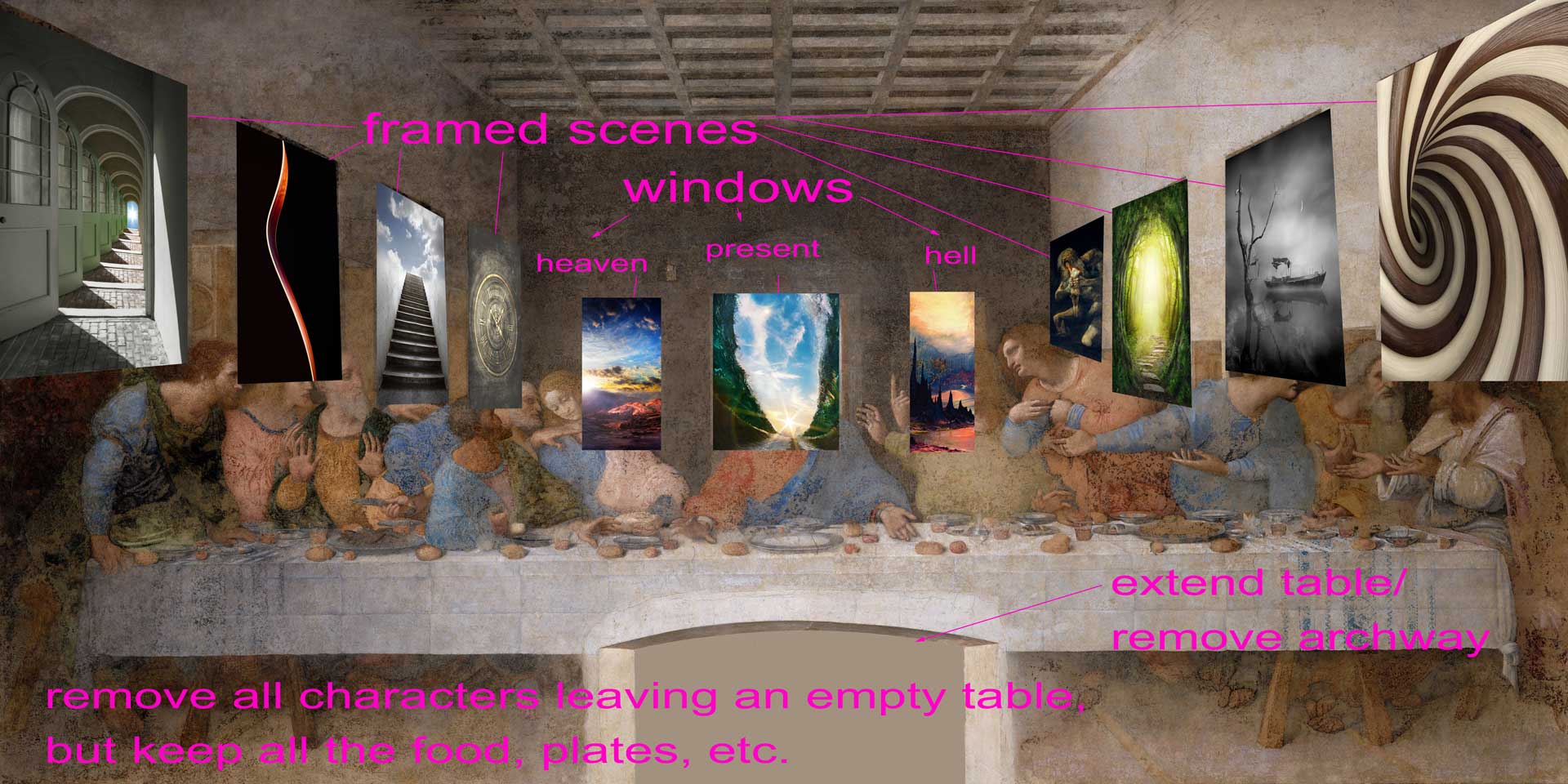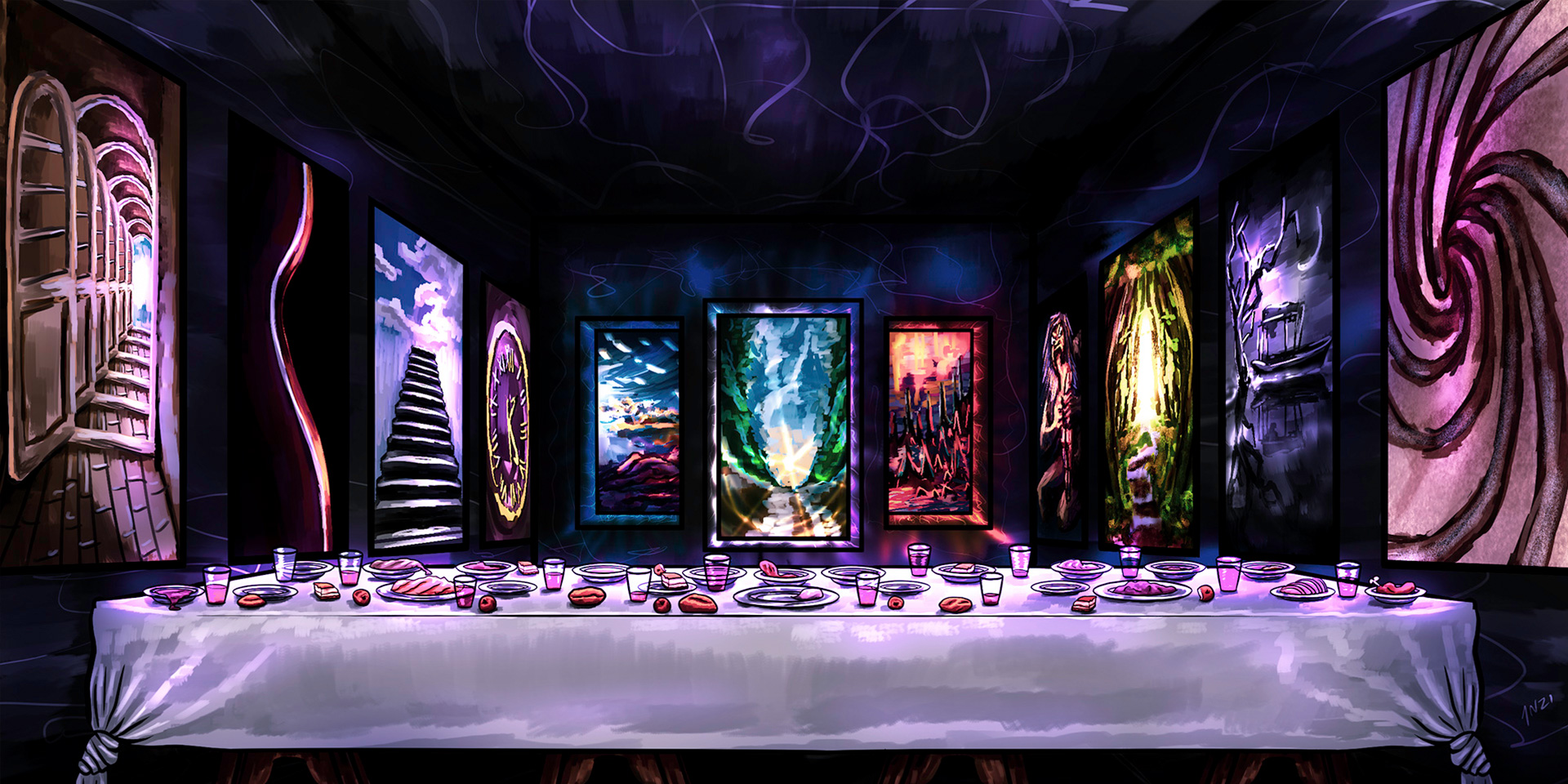Fatal Fire
Fatal Fire is a musical audio play I created—it’s part fictional story, part concept album, and part interactive media. Many of the characters in this story play music, so as a user interacts with different on-screen elements while reading, music and sounds play, which in turn unlocks the soundtrack on a centralized Music page. This ended up being a large project—the story is about 415,000 words over four acts, and the soundtrack is six+ hours of music, with an additional three+ hours of background music, and another hour+ of score and source sounds—the background music, score, and source sounds are only accessible within the scenes of story. I officially announced this story on Easter Sunday 2024.
You can visit this project at fatalfire.com
Fatal Fire — an overview
I began sketching ideas for the story in 2014 and writing/recording some of the music in 2016. I played all of the instruments and programmed the drums in my home studio with the exception of three tracks on which my brother, Chris, played bass. I sang lead vocals on most tracks as one of the main characters in the story, and sang background vocals on all but two of the tracks; roughly a dozen other talented singers contributed vocal performances as different characters in the story. I completed all of recording, editing, and sound production for each track at my studio, and then my friend Walt re-amped each instrument group on every track through an analog signal channel chain in his studio; Walt and I had identical hardware chains in our studios for the devices we used to process these tracks. After the reamping stage was applied to all tracks, Walt directed the final mixdown and pre-mastering at my studio. Our friend Mike , then, completed the final mastering at Sony Studios in Battery Park.
I composed all of the music and lyrics in Fatal Fire soundtrack with the exception of three songs in which I co-wrote the music with my brother, Chris, and a few art music pieces that I arranged for modern instruments. Some of the songs in Fatal Fire were based on material I’d written with the band Clear Blue from the mid-1990s to early 2000s; the Fatal Fire story is largly set in this same time period—I love music from that era—and I tried to impart some of the indie-recording sonic charm from that period into the production. Fatal Fire has four main types of audio that readers encounter while they progress through the story: source music tracks, which are generally songs performed by characters in the story—this is the main "soundtrack" of Fatal Fire that appear in the story narrative and are then unlocked on the Music page, score tracks which play during scenes in the story narrative, background tracks that play softly in scenes taking place in different venues and locations in the story, and various sounds that characters make during the story—a one-shot guitar riff, for example. There are 70+ source tracks in the soundtrack, 40+ score tracks, 30+ background tracks, and 90+ sounds; I prepared alternate/variant versions of many of these recordings that, for example, include sound design elements like audience applause and ambient noise to give the listener a sense that they’re immersed in the story. Early on, I wrote up a design document about how the various audio players might function to create an interesting experience for readers, and my friends Jake and Gabe helped make sense of how the various audio players could be developed—Jake was the lead developer of the interactive site, and, really, the Fatal Fire site wouldn't be what it is without his involvement.
My friends and I developed a variety of tools to help me reach my vision for both the story and the music of Fatal Fire; a lot of this development was about creating efficient workflows. For example, I knew from previous projects that I'd need a convenient workflow for getting story narrative from my text editor, which is simple text, and into the interactive platform that Jake and Gabe were developing, which is not simple text! So I developed a markup syntax paired with a RegEx script that I used throughout the story to label, for instance, <music></music> and <background></background> tracks, which would be later parsed by a giant RegEx function and convert all of the narrative into a format that could be viewed on the live server—as Jake and Gabe made revisions to the code, I made small changes to my RegEx function, which meant that I didn't have to change anything in the story.
a workflow for migrating story narrative to the interactive platform
This allowed me to write and place interactive elements in the story with the assurance that whereever I chose to, for instance, swap a non-looping background track for a one-shot sound, I could simply change <backgroundnl>Diner Radio</backgroundnl> to <sound>Diner sounds Radio</sound> and the correct interactive elements would translate properly on the site once I ran the RegEx function on the story text and pushed that code up to our repository. Jake developed a few different server-side "interpreters" so that chapter titles, music track names, and other database elements could all be pulled, sorted, formatted, and displayed dynamically from within the marked-up story text I provided—this gave me even more control to create, modify, and rearrange all of the elements in the story without having to worry about breaking the interactive site.
sounds in a diner including an old radio playing in the background, which readers can "Focus" on while immersing into the scene
There were dozens of custom audio tools that I also developed as a part of this project—some software, some hardware. For example, I ran into a problem early in the production where I wanted to layer both pickup signals of my guitar simultaneously and discretely with different amplifier and effects settings, but this functionality was not readily possible with electric guitars, so my friend Ryan and I collaborated on a multi-pickup audio jack , which, ultimately, gave me this functionality. This was used on many songs and is particularly helpful on single-guitar power trio songs like “the Spark” and “Disengage”—you can hear some of the capabilities of using multiple timbres from different pickups (two magnetic pickups and one piezo pickup) from a single instrument source in order to produce a layered sound—each discrete signal evolves and decays at different rates, so even a single boring note has a novel dimensional quality. There were a variety of other hardware mods to electronics and instruments as part of the recording process including this 12-string electric guitar conversion, which can be heard prominently on "Recurrence" and "How I Love You". There were also lots of software systems I developed to process the sounds in novel ways for particular compositions like this unique delay effect, which can be heard on "Disengage".
a custom hardware tool used for some of the recording
a custom software tool used for parts of the score
It was important to me that I distinguished the timbres between the various musical characters in this story; that is, I wanted all of the recordings for the soundtrack and the score to feel like they belonged to the same universe, but I wanted each musical band/ensemble/entity to have its own distinct voice. The main ensemble in the story evolves in their musicianship skills over time, and they also compose and peform music in a few different styles—I tried to allow these pieces to reflect these musicianship differences while also retaining elements of their original timbre to some degree—that was challenging. Part of my approach to accomplishing this was to keep the timbres of each instrument consistent throughout the story—despite changes in both time and style—and to, by and large, allow the compositions and the production to change considerably; specifically, I dedicated specific instruments, amplifiers, effects, and so on to different characters in the story and didn't allow two characters to use, for example, the same drum kit sound—this is a subtle detail, I know. I ultimately made a variety of "sound templates " for each ensemble in the story—even though the music performed may vary greatly in style for a given ensemble, the limited timbral palette, I feel, helps unify these pieces. Additionally, the re-amping process was a critical part of our production and ultimately helped the many disparate ensembles that perform throughout the story (with different timbres, styles, effects, etc.) to have a unified sound; you can get a closer look at the analog hardware we used for re-amping and the settings we used by downloading this "Recall Sheet" tool I created—a convenient alternative to paper recall sheets typically used in a studio when dialing in device settings. The timbre allocations for each ensemble are noted herein:
—I performed all of the electric guitar parts associated with the character "Lylia" on one of my many
Parker Fly
guitars.
—I performed all of the bass guitar parts associated with the characters "Lylia" and "Jacob" on this
Parker Fly Bass
; the character "Jacob" also played a rhythm guitar part on "Tears", which I performed on a Moog E-1 guitar.
—I performed all of the guitar parts associated with characters in "United Band" on this
Fender Telecaster
and this
Partscaster
.
—I performed all of the electric guitar parts associated with the character "Gene" on this
Fender Stratocaster
and this
Parker NiteFly
—I performed all of the electric guitar parts associated with the guitarist of "Tessitura" on this
T4RS-equipped
Gibson SG
, and with the band "Visigoth" on this
Parker Fly Deluxe .
—I performed all of the acoustic guitar parts throughout the story on two
Parker Fly Concert
guitars (one tuned in B standard like a baritone) processed through this
Fishman Aura Sixteen
, and on this mic'd
Ken Parker acoustic archtop
guitar, and this mic'd and DI'd
Takamine flattop acoustic
guitar.
—I performed all of the nylon string guitar parts in the score on this
Parker Fly Nylon
and in the story on this
Godin Multiac
.
—I performed additional bass guitar parts on this
Fender P-bass
, Chris performed his bass parts on a Lakeland bass for "the Spark", "We Lift Our Hands", and the solo section of "Endlessly", I performed on a Hulse fretless bass on "Twins of a Gazelle" and a Spector 5-string bass on "You".
—I programmed all of the guitar amp sounds in
Positive Grid
Bias Amp and Bias FX.
—I sequenced/programmed all of the drum parts for use with
Addictive Drums
.
—I performed/recorded/programmed all of the piano parts for use with
Addictive Keys
; all synthesizers through
Native Instruments
Kontakt, Massive, and FM8; all orchestral instrument parts through
Miroslav Philharmonic
and
Native Instruments
Kontakt.
One of my favorite aspects of the music for this story is the "Background Tracks", which play softly in certain scenes with some added ambience and room noise—the intention was the help readers feel like they're in the location while they're reading each scene. I had conceived of a feature in the interactive story we called "
Focus
", which, when the "Focus" button is pressed, brings the background music to the forefront and reduces the ambient noises/filters—this is similar to the way, in real life, that one might focus on the music playing in a restaurant and tune out all of the ambient noise in the environment. The background tracks are an essential part of the immersive experience in my mind, so I wanted those tracks, too, to have a feel and timbres that were unlike the sounds of other ensembles in the story, so the instruments, amplifiers, effects, and so on used for background tracks vary widely, but, of course, don't overlap the tools used to make music by other characters.
Throughout the soundtrack to Fatal Fire are many musical references to compositions/composers that I really like—some of these references are more subtle than others. Additionally, there are a handful of works by composers that appear in more complete contexts within the story narrative as noted below:
—"Night and Dreams" (Nacht und Träume) composed by
Franz Schubert
—"Sonatine" composed by
Maurice Ravel
—"Bouree" from Unaccompanied Cello Suite No. 4 in Eb major composed by
J.S. Bach
used in "Recital Hall Background"
—"Allemande" from French Suite No. 4 in Eb major composed by J.S. Bach and "Nocturne Op. 9 No. 2 in E-flat major" by
Frédéric Chopin
used in "Inside Cali's Car"
—“In the Basement” features excerpts quoted in the style of by J.S. Bach,
Niccolò Paganini
,
Ludwig van Beethoven
,
George Gershwin
—"Intermezzo" from Cavalleria rusticana composed by
Pietro Mascagni
used in "a Guitar with Electronics" along with "Bouree" by
Robert de Visée
used in "Effects", and "Little Fugue" by J.S. Bach used in "With a Pick".
Now let's talk about the visual elements of the story—there are almost none! I drew a map of the locations in the story, and, apart from that, it's really up to the writing and the sound design to inform the reader's imagination about what people and places look like. When I first began writing the story, I listened to hours and hours of "the Shadow" and other old-time radio shows—I'd envisioned Fatal Fire being more like this, but the interactive platform seemed like a better fit for the release of the story. The most compelling visual element of Fatal Fire is, of course, the so-called "Goth Supper"—I mocked up the laughable concept shown below, which was beautifully crafted by the amazing and talented Shayan .
All in all, the Fatal Fire production—the music/audio and the story/interactive platform—involved a small number of people (no robots, no AI, no ghosts...holy or otherwise, etc.). Every aspect of the story is completely free to experience—everything is unlocked for the reader as they continue to progress through each scene—but readers can, optionally, give some amount to the site to unlock the three main story albums. We then, in turn, take half of what we receive after transaction fees and give that to charities. The intention was to make the interactive site feel like a personal experience, so, in addition to it requiring a minimal amount of information in order to open an account, users can also write private notes on the page in the story as well as make bookmarks in the same way that one might scribble notes in the side margin of an actual book.



